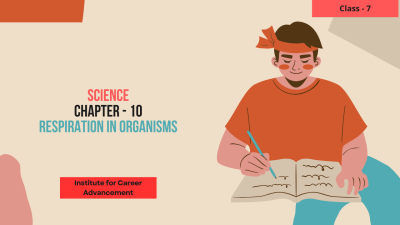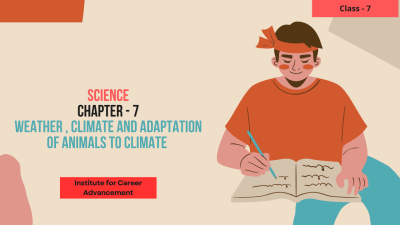Courses


 Compare
Compare
"Transportation in Animals and Plants" is a fundamental concept taught in Class 7 biology, focusing on how organisms move essential substances like water, nutrients, gases, and wastes within their bodies. In animals, this involves the circulatory system ; blood vessels, heart ; for transporting oxygen, nutrients, and waste products. In plants, transportation occurs through the vascular system : xylem and phloem, where xylem transports water and minerals from roots to leaves, and phloem transports sugars produced in leaves to other parts of the plant. Understanding these processes helps students grasp the mechanisms that sustain life in both animals and plants. "প্রাণী এবং উদ্ভিদে পরিবহন" হল ক্লাস 7 জীববিজ্ঞানে শেখানো একটি মৌলিক ধারণা, যেটি কীভাবে জীবগুলি তাদের শরীরের মধ্যে জল, পুষ্টি, গ্যাস এবং বর্জ্যের মতো প্রয়োজনীয় পদার্থগুলিকে স্থানান্তরিত করে তার উপর দৃষ্টি নিবদ্ধ করে৷ প্রাণীদের মধ্যে, এটি অক্সিজেন, পুষ্টি এবং বর্জ্য পণ্য পরিবহনের জন্য সংবহন ব্যবস্থা (রক্তবাহী জাহাজ, হৃদয়) জড়িত। উদ্ভিদে, ভাস্কুলার সিস্টেমের (জাইলেম এবং ফ্লোয়েম) মাধ্যমে পরিবহণ ঘটে, যেখানে জাইলেম শিকড় থেকে পাতায় জল এবং খনিজ পদার্থ পরিবহন করে এবং ফ্লোয়েম পাতায় উৎপন্ন শর্করা উদ্ভিদের অন্যান্য অংশে পরিবহন করে। এই প্রক্রিয়াগুলি বোঝা শিক্ষার্থীদের প্রাণী এবং উদ্ভিদ উভয়ের জীবনকে টিকিয়ে রাখার প্রক্রিয়াগুলি উপলব্ধি করতে সহায়তা করে।
₹599
0 Lessons
Hours

 Compare
Compare
Respiration in organisms is the biochemical process through which cells extract energy from organic molecules, typically glucose, to produce ATP (adenosine triphosphate). This energy is essential for various cellular activities, including growth, movement, and maintenance of life processes. There are two main types of respiration: Aerobic Respiration: Occurs in the presence of oxygen and involves the complete breakdown of glucose into carbon dioxide and water, releasing a large amount of ATP. Anaerobic Respiration: Occurs in the absence of oxygen and produces less ATP compared to aerobic respiration. It includes glycolysis followed by fermentation pathways, resulting in by-products like lactic acid (in animals) or ethanol and carbon dioxide (in yeast). জীবের শ্বসন হল জৈব রাসায়নিক প্রক্রিয়া যার মাধ্যমে কোষগুলি জৈব অণু, সাধারণত গ্লুকোজ থেকে শক্তি বের করে ATP (এডিনোসিন ট্রাইফসফেট) তৈরি করে। এই শক্তি বিভিন্ন সেলুলার ক্রিয়াকলাপের জন্য প্রয়োজনীয়, যার মধ্যে বৃদ্ধি, চলাচল এবং জীবন প্রক্রিয়াগুলির রক্ষণাবেক্ষণ সহ। দুটি প্রধান ধরনের শ্বসন আছে: অ্যারোবিক শ্বসন: অক্সিজেনের উপস্থিতিতে ঘটে এবং কার্বন ডাই অক্সাইড এবং জলে গ্লুকোজের সম্পূর্ণ ভাঙ্গন জড়িত, প্রচুর পরিমাণে ATP নির্গত করে। অ্যানেরোবিক শ্বসন: অক্সিজেনের অনুপস্থিতিতে ঘটে এবং বায়বীয় শ্বাস-প্রশ্বাসের তুলনায় কম ATP উৎপন্ন করে। এর মধ্যে রয়েছে গ্লাইকোলাইসিস এর পরে গাঁজন পথ, যার ফলে উপ-পণ্য যেমন ল্যাকটিক অ্যাসিড (প্রাণীতে) বা ইথানল এবং কার্বন ডাই অক্সাইড (খামিরে)।
₹599
0 Lessons
Hours

 Compare
Compare
Soil is the loose surface material that covers most land. It consists of inorganic particles and organic matter. Soil provides the structural support for plants used in agriculture and is also their source of water and nutrients. Soils vary greatly in their chemical and physical properties. Processes such as leaching, weathering and microbial activity combine to make a whole range of different soil types. Each type has particular strengths and weaknesses for agricultural production. মাটি হল আলগা পৃষ্ঠের উপাদান যা বেশিরভাগ জমিকে জুড়ে দেয়। এটি অজৈব কণা এবং জৈব পদার্থ নিয়ে গঠিত। মাটি কৃষিতে ব্যবহৃত উদ্ভিদের জন্য কাঠামোগত সহায়তা প্রদান করে এবং তাদের জল ও পুষ্টির উৎসও বটে। মাটি তাদের রাসায়নিক এবং ভৌত বৈশিষ্ট্যে ব্যাপকভাবে পরিবর্তিত হয়। লিচিং, ওয়েদারিং এবং মাইক্রোবায়াল কার্যকলাপের মতো প্রক্রিয়াগুলি বিভিন্ন ধরণের মাটির সম্পূর্ণ পরিসর তৈরি করতে একত্রিত হয়। প্রতিটি প্রকারেরই কৃষি উৎপাদনের জন্য বিশেষ শক্তি এবং দুর্বলতা রয়েছে।
₹599
0 Lessons
Hours

 Compare
Compare
Wind: Definition: Wind is the movement of air relative to the Earth's surface. It is caused by differences in air pressure due to uneven heating of the Earth's surface by the sun. Characteristics: Direction and Speed: Wind can blow in different directions and at various speeds. Types: Winds are categorized based on their origin and characteristics, such as local winds (sea breeze, land breeze) and global winds (trade winds, westerlies). Importance: Wind plays a crucial role in shaping weather patterns, dispersing seeds and pollen, generating electricity (wind turbines), and influencing ocean currents. Storms: Definition: Storms are disturbances in the atmosphere characterized by strong winds, precipitation (rain, snow, hail), thunder, lightning, and sometimes turbulence. Types of Storms: Thunderstorms: Brief but intense storms with lightning, thunder, heavy rain, and sometimes hail. Tropical Storms: Cyclonic storms that form over warm ocean waters, with winds ranging from 39 to 73 mph (63 to 118 km/h). Winter Storms: Heavy snowfall accompanied by strong winds and freezing temperatures. Impact: Storms can cause damage to property, disrupt transportation and communication, and pose risks to human safety due to strong winds, lightning strikes, and flooding. Cyclones: Definition: Cyclones are large-scale rotating storm systems characterized by low-pressure centers, strong winds spiraling inward, and heavy rain. Types of Cyclones: Tropical Cyclones: Intense low-pressure systems that form over warm ocean waters and can develop into hurricanes, typhoons, or cyclones depending on the region. Extratropical Cyclones: Cyclones that form outside the tropics, often associated with fronts and characterized by a mixture of warm and cold air masses. বায়ু: সংজ্ঞা: বায়ু হল পৃথিবীর পৃষ্ঠের সাপেক্ষে বাতাসের গতিবিধি। এটি সূর্য দ্বারা পৃথিবীর পৃষ্ঠের অসম উত্তাপের কারণে বায়ুচাপের পার্থক্যের কারণে ঘটে। বৈশিষ্ট্য: দিক এবং গতি: বাতাস বিভিন্ন দিকে এবং বিভিন্ন গতিতে বইতে পারে। প্রকারভেদ: বায়ুকে তাদের উৎপত্তি এবং বৈশিষ্ট্যের উপর ভিত্তি করে শ্রেণীবদ্ধ করা হয়, যেমন স্থানীয় বায়ু (সমুদ্রের হাওয়া, স্থল বাতাস) এবং বৈশ্বিক বায়ু (বাণিজ্য বায়ু, পশ্চিমাঞ্চল)। গুরুত্ব: বায়ু আবহাওয়ার ধরণ গঠনে, বীজ এবং পরাগ বিচ্ছুরণে, বিদ্যুৎ উৎপাদনে (বায়ু টারবাইন) এবং সমুদ্রের স্রোতকে প্রভাবিত করতে গুরুত্বপূর্ণ ভূমিকা পালন করে। ঝড়: সংজ্ঞা: ঝড় হল বায়ুমন্ডলে বিঘ্নিত হওয়া যা প্রবল বাতাস, বৃষ্টিপাত (বৃষ্টি, তুষার, শিলাবৃষ্টি), বজ্রপাত, বজ্রপাত এবং কখনও কখনও অশান্তি দ্বারা চিহ্নিত করা হয়। ঝড়ের ধরন: বজ্রঝড়: বজ্রপাত, বজ্রপাত, ভারী বৃষ্টি এবং কখনও কখনও শিলাবৃষ্টি সহ সংক্ষিপ্ত কিন্তু তীব্র ঝড়। গ্রীষ্মমন্ডলীয় ঝড়: ঘূর্ণিঝড় যা উষ্ণ সমুদ্রের জলের উপর তৈরি হয়, যার গতিবেগ 39 থেকে 73 মাইল প্রতি ঘন্টা (63 থেকে 118 কিমি/ঘন্টা)। শীতকালীন ঝড়: প্রবল তুষারপাত সহ প্রবল বাতাস এবং হিমাঙ্কের তাপমাত্রা। প্রভাব: ঝড় সম্পত্তির ক্ষতি করতে পারে, পরিবহন ও যোগাযোগ ব্যাহত করতে পারে এবং প্রবল বাতাস, বজ্রপাত এবং বন্যার কারণে মানুষের নিরাপত্তার জন্য ঝুঁকি তৈরি করতে পারে। ঘূর্ণিঝড়: সংজ্ঞা: ঘূর্ণিঝড় হল বৃহৎ আকারের ঘূর্ণায়মান ঝড়ের ব্যবস্থা যা নিম্নচাপ কেন্দ্র, প্রবল বাতাস ভিতরের দিকে সঞ্চারিত হয় এবং ভারী বৃষ্টিপাত দ্বারা চিহ্নিত করা হয়। ঘূর্ণিঝড়ের প্রকারভেদ: গ্রীষ্মমন্ডলীয় ঘূর্ণিঝড়: তীব্র নিম্নচাপ সিস্টেম যা উষ্ণ সমুদ্রের জলের উপর তৈরি হয় এবং অঞ্চলের উপর নির্ভর করে হারিকেন, টাইফুন বা ঘূর্ণিঝড়ে পরিণত হতে পারে। এক্সট্রাট্রপিকাল সাইক্লোন: ঘূর্ণিঝড় যা গ্রীষ্মমন্ডলীয় অঞ্চলের বাইরে তৈরি হয়, প্রায়শই ফ্রন্টের সাথে যুক্ত এবং উষ্ণ এবং ঠান্ডা বাতাসের মিশ্রণ দ্বারা চিহ্নিত করা হয়।
₹599
0 Lessons
Hours

 Compare
Compare
The weather of a location refers to the day-to-day conditions of the atmosphere in terms of temperature, humidity, rainfall, wind speed, etc. The components of the weather are temperature, humidity, and other aspects. The weather in a location fluctuates from day to day and week to week. The climate of an area is defined as the average weather pattern over a lengthy period, like 25 years. Climate has a significant impact on all living species. Animals have evolved to survive in the environments in which they reside. Animals in extremely cold or hot climates must have particular characteristics to defend themselves from excessive cold or heat. একটি অবস্থানের আবহাওয়া তাপমাত্রা, আর্দ্রতা, বৃষ্টিপাত, বাতাসের গতি ইত্যাদির পরিপ্রেক্ষিতে বায়ুমণ্ডলের প্রতিদিনের অবস্থাকে বোঝায়। আবহাওয়ার উপাদানগুলি হল তাপমাত্রা, আর্দ্রতা এবং অন্যান্য দিক। একটি অবস্থানের আবহাওয়া দিনে দিনে এবং সপ্তাহ থেকে সপ্তাহে ওঠানামা করে। একটি এলাকার জলবায়ুকে 25 বছরের মতো দীর্ঘ সময়ের গড় আবহাওয়ার ধরণ হিসাবে সংজ্ঞায়িত করা হয়। জলবায়ু সমস্ত জীবন্ত প্রজাতির উপর একটি উল্লেখযোগ্য প্রভাব ফেলে। প্রাণীরা যে পরিবেশে বাস করে সেখানে বেঁচে থাকার জন্য বিবর্তিত হয়েছে। অত্যধিক ঠান্ডা বা গরম জলবায়ুতে থাকা প্রাণীদের অতিরিক্ত ঠান্ডা বা তাপ থেকে নিজেদের রক্ষা করার জন্য বিশেষ বৈশিষ্ট্য থাকতে হবে।
₹599
0 Lessons
Hours

 Compare
Compare
Physical changes are the changes to a substance’s physical attributes, such as form, size, shape, and states. These alterations result in the formation of no new compounds. These modifications might as well be reversible. A phase change is regarded as a change in the form of matter, often known as a physical change. Liquid water turning to solid ice or going through evaporation to form water, the gaseous state of water, are both examples of physical changes. Boiling as well as evaporation are examples of phase transitions. Chemical changes are the changes that alter the chemistry including composition or structure of a substance. ভৌত পরিবর্তন হল একটি পদার্থের শারীরিক বৈশিষ্ট্যের পরিবর্তন, যেমন ফর্ম, আকার, আকৃতি এবং অবস্থা। এই পরিবর্তনের ফলে কোন নতুন যৌগ তৈরি হয় না। এই পরিবর্তনগুলিও বিপরীত হতে পারে। একটি পর্যায় পরিবর্তনকে পদার্থের আকারে পরিবর্তন হিসাবে বিবেচনা করা হয়, যা প্রায়ই একটি শারীরিক পরিবর্তন হিসাবে পরিচিত। তরল পানি কঠিন বরফে পরিণত হওয়া বা বাষ্পীভবনের মধ্য দিয়ে পানি তৈরি করা, পানির বায়বীয় অবস্থা, উভয়ই শারীরিক পরিবর্তনের উদাহরণ। ফুটন্ত এবং সেইসাথে বাষ্পীভবন ফেজ ট্রানজিশনের উদাহরণ। রাসায়নিক পরিবর্তনগুলি এমন পরিবর্তন যা পদার্থের গঠন বা গঠন সহ রসায়নকে পরিবর্তন করে।
₹599
0 Lessons
Hours

 Compare
Compare
Acid:- An acid is defined as a substance whose water solution tastes sour, turns blue litmus red, and neutralizes bases. Base:- A substance is called base if its aqueous solution tastes bitter, turns red litmus blue, or neutralizes acids. Salt:- Salt is a neutral substance whose aqueous solution does not affect litmus. অ্যাসিড:- অ্যাসিডকে এমন একটি পদার্থ হিসাবে সংজ্ঞায়িত করা হয় যার জলের দ্রবণ টক স্বাদযুক্ত, নীল লিটমাসকে লাল করে এবং ভিত্তিগুলিকে নিরপেক্ষ করে। ভিত্তি:- কোন পদার্থের জলীয় দ্রবণ যদি তিক্ত স্বাদের হয়, লাল লিটমাস নীল হয়ে যায় বা অ্যাসিডকে নিরপেক্ষ করে তাহলে তাকে বেস বলে। লবণ:- লবণ একটি নিরপেক্ষ পদার্থ যার জলীয় দ্রবণ লিটমাসকে প্রভাবিত করে না।
₹599
0 Lessons
Hours

 Compare
Compare
Heat is a form of energy which produces sensation of warmth and flows when there is a temperature difference between two bodies. The heat energy can be converted to other forms of energy like kinetic energy, mechanical energy etc. তাপ হল একধরনের শক্তি যা উষ্ণতার অনুভূতি তৈরি করে এবং যখন দুটি দেহের মধ্যে তাপমাত্রার পার্থক্য থাকে তখন প্রবাহিত হয়। তাপ শক্তি অন্যান্য শক্তিতে রূপান্তরিত হতে পারে যেমন গতিশক্তি, যান্ত্রিক শক্তি ইত্যাদি।
₹599
0 Lessons
Hours

 Compare
Compare
Fibres are very thin, thread-like strands from which fabrics (or cloths) are made. Some examples of fibres are cotton, wool, silk, flax, jute, nylon, polyester and polyacrylic. The fibres are spun into yarn (long continuous thread) which can then be woven on a loom to make a fabric (or cloth). Yam is a kind of long, twisted thread. Yarn is made from fibres by the process of spinning. There are two types of fibres, i.e. natural fibre and man-made fibre (nylon, rayon). Some of our clothes are made from yarn derived from the animal fibre. These are the types of natural fibres as they are obtained from nature. Natural fibres are the fibres which are obtained from natural sources like plants and animals. In Class VI, we have learnt about some fibres obtained from plants. In this chapter, we will study about some fibres obtained from animals. Wool and silk fibres are obtained from animals. Wool is obtained from the fleece (hair) of sheep or yak and silk fibres come from cocoons of the silk moth. ফাইবারগুলি খুব পাতলা, থ্রেডের মতো স্ট্র্যান্ড যা থেকে কাপড় (বা কাপড়) তৈরি করা হয়। তন্তুর কিছু উদাহরণ হল তুলা, উল, সিল্ক, শণ, পাট, নাইলন, পলিয়েস্টার এবং পলিঅ্যাক্রিলিক। ফাইবারগুলিকে সুতোয় (দীর্ঘ একটানা সুতো) তৈরি করা হয় যা পরে তাঁতে বোনা যায় একটি ফ্যাব্রিক (বা কাপড়) তৈরি করতে। ইয়াম হল এক ধরনের লম্বা, পেঁচানো সুতো। সুতা স্পিনিং প্রক্রিয়ার মাধ্যমে তন্তু থেকে তৈরি করা হয়। দুই ধরনের ফাইবার আছে, যেমন প্রাকৃতিক ফাইবার এবং মনুষ্যসৃষ্ট ফাইবার (নাইলন, রেয়ন)। আমাদের কিছু কাপড় পশুর ফাইবার থেকে প্রাপ্ত সুতা দিয়ে তৈরি। এগুলি প্রকৃতি থেকে প্রাপ্ত হওয়ায় প্রাকৃতিক তন্তুর ধরন। প্রাকৃতিক তন্তু হল সেই ফাইবার যা উদ্ভিদ ও প্রাণীর মতো প্রাকৃতিক উৎস থেকে প্রাপ্ত হয়। ষষ্ঠ শ্রেণিতে, আমরা গাছপালা থেকে প্রাপ্ত কিছু তন্তু সম্পর্কে শিখেছি। এই অধ্যায়ে, আমরা প্রাণীদের থেকে প্রাপ্ত কিছু তন্তু সম্পর্কে অধ্যয়ন করব। পশম এবং রেশম তন্তু প্রাণীদের থেকে পাওয়া যায়। ভেড়া বা ইয়াকের লোম (লোম) থেকে পশম পাওয়া যায় এবং রেশম মথের কোকুন থেকে রেশম তন্তু পাওয়া যায়।
₹599
0 Lessons
Hours